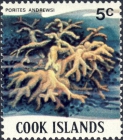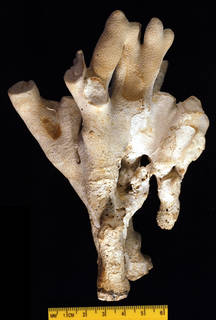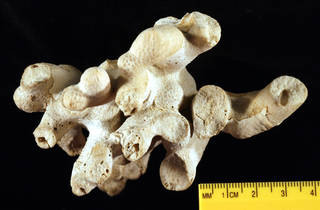
| Intro | | About | | Wiki | | Search traits | | Data explorer | | Literature | | Definitions | | Sources | | Webservices | | Statistics | | Feedback | | Editors | | Log in |
WoRMS taxon detailsPorites cylindrica Dana, 1846
207229 (urn:lsid:marinespecies.org:taxname:207229)
accepted
Species
Porites (Porites) cylindrica Dana, 1846 · unaccepted > superseded combination
Porites andrewsi Vaughan, 1918 · unaccepted > junior subjective synonym
Porites capricornis Rehberg, 1892 · unaccepted > junior subjective synonym
Porites galeata Nemenzo, 1955 · unaccepted > junior subjective synonym (?)
Porites laevis Dana, 1846 · unaccepted > junior subjective synonym (misspelling)
Porites levis Dana, 1846 · unaccepted > junior subjective synonym
Porites planocella Nemenzo, 1955 · unaccepted > junior subjective synonym
marine,
Dana, J.D. (1846-1849). Zoophytes. United States Exploring Expedition during the years 1838-1842. <em>Lea and Blanchard, Philadelphia.</em> 7: 1-740, 61 pls. (1846: 1-120, 709-720; 1848: 121-708, 721-740; 1849: atlas pls. 1-61)., available online at https://www.biodiversitylibrary.org/page/18989497, http://www.sil.si.edu/digitalcollections/usexex/navigation/ScientificText/USExEx19_08select.cfm [details]
Type locality contained in Fijian Exclusive Economic Zone
type locality contained in Fijian Exclusive Economic Zone [details]
Unreviewed
Type locality Fiji (Veron, 1986). [details]
Description A branching Porites, developing truly ramose skeletons which can cover many square metres. Branches are smooth on the...
Description A branching Porites, developing truly ramose skeletons which can cover many square metres. Branches are smooth on the surface, though they are usually of uneven cross-section. The preferred habitat is sheltered water, such as lagoons and back-reef areas, and they can form substantial micro-atolls. The colour is pale brown. The species is similar to Porites nigrescens, which is generally slightly smaller, with a rougher surface (Sheppard, 1998). Colonies are branching, sometimes with an encrusting base. Corallites are very shallow. Colour: Usually cream, yellow, blue or green. Abundance: very common and may be a dominant in lagoons or on back reef margin (Veron, 1986). [details]
Hoeksema, B. W.; Cairns, S. (2025). World List of Scleractinia. Porites cylindrica Dana, 1846. Accessed through: World Register of Marine Species at: https://www.marinespecies.org/aphia.php?p=taxdetails&id=207229 on 2025-07-15
Date action by 2000-09-13 07:19:12Z changed Garcia, Maria
Nomenclatureoriginal description
Dana, J.D. (1846-1849). Zoophytes. United States Exploring Expedition during the years 1838-1842. <em>Lea and Blanchard, Philadelphia.</em> 7: 1-740, 61 pls. (1846: 1-120, 709-720; 1848: 121-708, 721-740; 1849: atlas pls. 1-61)., available online at https://www.biodiversitylibrary.org/page/18989497, http://www.sil.si.edu/digitalcollections/usexex/navigation/ScientificText/USExEx19_08select.cfm [details] original description (of Porites andrewsi Vaughan, 1918) Vaughan TW. (1918). Some shallow-water corals from Murray Island (Australia), Cocos-Keeling Island, and Fanning Island. <em>Papers from the Department of Marine Biology of the Carnegie Institution of Washington.</em> 9 (213): 49-234, pls. 20-93. [details] original description (of Porites levis Dana, 1846) Dana, J.D. (1846-1849). Zoophytes. United States Exploring Expedition during the years 1838-1842. <em>Lea and Blanchard, Philadelphia.</em> 7: 1-740, 61 pls. (1846: 1-120, 709-720; 1848: 121-708, 721-740; 1849: atlas pls. 1-61)., available online at https://www.biodiversitylibrary.org/page/18989497, http://www.sil.si.edu/digitalcollections/usexex/navigation/ScientificText/USExEx19_08select.cfm [details] original description (of Porites capricornis Rehberg, 1892) Rehberg, H. (1892). Neue und wenig bekannte Korallen. <em>Abhandlungen aus dem Gebiete der Naturwissenschaften Hamburg.</em> 12: 1-50. [details] original description (of Porites (Porites) cylindrica Dana, 1846) Dana, J.D. (1846-1849). Zoophytes. United States Exploring Expedition during the years 1838-1842. <em>Lea and Blanchard, Philadelphia.</em> 7: 1-740, 61 pls. (1846: 1-120, 709-720; 1848: 121-708, 721-740; 1849: atlas pls. 1-61)., available online at https://www.biodiversitylibrary.org/page/18989497, http://www.sil.si.edu/digitalcollections/usexex/navigation/ScientificText/USExEx19_08select.cfm [details] original description (of Porites planocella Nemenzo, 1955) Nemenzo, F. (1955). Systematic studies on Philippine shallow water scleractinians: I. Suborder Fungiida. <em>Natural and Applied Science Bulletin, University of the Philippines.</em> 15: 3-84. [details] original description (of Porites galeata Nemenzo, 1955) Nemenzo, F. (1955). Systematic studies on Philippine shallow water scleractinians: I. Suborder Fungiida. <em>Natural and Applied Science Bulletin, University of the Philippines.</em> 15: 3-84. [details] basis of record Veron JEN. (1986). Corals of Australia and the Indo-Pacific. <em>Angus & Robertson Publishers.</em> [details] Othercontext source (HKRMS)
Veron JEN. (1982). Hermatypic Scleractinia of Hong Kong - An annotated list of species. <em>Proceedings of the first international marine biological workshop: The marine flora and fauna of Hong Kong and southern China (ed. Morton, B.). Hong Kong University Press, Hong Kong.</em> 1: 111-125. [details]
context source (Hexacorallia) Fautin, Daphne G. (2013). Hexacorallians of the World. (look up in IMIS) [details] additional source Wijsman-Best M, Faure G, Pichon M. (1980). Contribution to the knowledge of the stony corals from the Seychelles and Eastern Africa. <em>Revue Zoologique Africaine.</em> 3: 600-627, pls. 9-`12. [details] additional source Hoffmeister, J.E. (1925). Some corals from America Samoa and the Fiji Islands. <em>Papers from the Department of Marine Biology of the Carnegie Institution of Washington.</em> 22: 1-90, pls. 1-23. page(s): 78 [details] additional source Vaughan TW. (1918). Some shallow-water corals from Murray Island (Australia), Cocos-Keeling Island, and Fanning Island. <em>Papers from the Department of Marine Biology of the Carnegie Institution of Washington.</em> 9 (213): 49-234, pls. 20-93. [details] additional source Quelch J.J. (1886). Report on the Reef-corals collected by H.M.S. 'Challenger' during the years 1873-76. <em>Report on the Scientific Results of the Voyage of H.M.S. Challenger during the years 1873–1876. Zoology.</em> 16 (46): 1-203, pls 1-12., available online at http://www.19thcenturyscience.org/HMSC/HMSC-Reports/Zool-46/README.htm page(s): 19, 201 [details] additional source Dana, J.D. (1846-1847). On Zoophytes. <em>The American Journal of Science and Arts, Second Series.</em> 2(4): 64-69; 2(5): 187-202; 3(7): 1-24; 3(8): 160-163; 3(9): 337-347. New-Haven., available online at https://www.biodiversitylibrary.org/page/28135503 page(s): 551, 559-560 [details] additional source Cairns, S.D., B.W. Hoeksema & J. van der Land. (1999). Appendix: List of extant stony corals. <em>Atoll Research Bulletin.</em> 459: 13-46. page(s): 38 [details] additional source Cairns, S.D., B.W. Hoeksema & J. van der Land. (2007). as a contribution to UNESCO-IOC Register of Marine Organisms. (look up in IMIS) [details] additional source Liu, J.Y. [Ruiyu] (ed.). (2008). Checklist of marine biota of China seas. <em>China Science Press.</em> 1267 pp. (look up in IMIS) [details] Available for editors additional source Benzoni, F., Stefani, F. 2012. Porites fontanesii, a new species of hard coral (Scleractinia, Poritidae) from the southern Red Sea, the Gulf of Tadjoura, and the Gulf of Aden, and its phylogenetic relationships within the genus. Zootaxa 3447: 56–68. page(s): 65 [details] additional source Rehberg, H. (1892). Neue und wenig bekannte Korallen. <em>Abhandlungen aus dem Gebiete der Naturwissenschaften Hamburg.</em> 12: 1-50. page(s): 47 [details] additional source Veron JEN. (2000). Corals of the World. Vol. 1–3. <em>Australian Institute of Marine Science and CRR, Queensland, Australia.</em> [details] additional source Veron JEN. (2002). New species described in Corals of the World. <em>Australian Institute of Marine Science Monograph Series.</em> 11: 1-209. page(s): 190 [details] additional source Forsman, Z. H.; Birkeland, C. (2009). Porites randalli: a new coral species (Scleractinia, Poritidae) from American Samoa. <em>Zootaxa.</em> 2244: 51-59. page(s): 52 [details] additional source Pichon, M.; Benzoni, F. (2007). Taxonomic re-appraisal of zooxanthellate Scleractinian Corals in the Maldive Archipelago. <em>Zootaxa.</em> 1441: 21–33. page(s): 31 [details] additional source Veron JEN, Marsh LM. (1988). Hermatypic corals of Western Australia : records and annotated species list. <em>Records Western Australian Museum Supplement.</em> 29: 1-136., available online at https://doi.org/10.5962/bhl.title.60555 page(s): 33, 66 [details] additional source Rathbun, R. (1887). Annotated catalogue of the species of Porites and Synaraea in the U.S.N.M., with the description of a new species of Porites. Proceedings of the United States National Museum, 10: 354-366 page(s): 361 [details] additional source Rehberg, H. (1893). Neue und wenig Bekannte Korallen. <em>Abhandlungen der Naturwissenschaften Verein, Hamburg.</em> 12, 1-50. page(s): 47 [details] additional source Veron, J. E. N. (2000). Corals of the World, Volume III: Families Mussidae, Faviidae, Trachyphylliidae, Poritidae. Australian Institute of Marine Science. Townsville., volume 3, pp. 490. page(s): 332-333 [details] additional source Astalhov, D. A. (2002). Species composition of anemonefishes (Perciformes, Pomacentridae) and their host sea anemones (Cnidaria, Actiniaria) in the Khanhhoa Province (South Vietnam). Journal of Ichthyology, 42(1): 37-50 page(s): 41 [details] additional source Cornish, A. S.; DiDonato, E. M. (2004). Resurvey of a reef flat in American Samoa after 85 years reveals devastation to a soft coral (Alcyonacea) community. Marine Pollution Bulletin, 48, 768-777 page(s): 773, 774, 775 [details] additional source Reinicke, G. B.; van Ofwegen, L. P. (1999). Soft corals (Alcyonacea: Octocorallia) from shallow water in the Chagos Archipelago: species assemblages and their distribution. Linnean Society Occasional Publications, 2, 67-85, plates 1-10 page(s): 90 [details] additional source Kühlmann, D. H. H. (2006). Die Steinkorallensammlung im Naturhistorischen Museum in Rudolstadt (Thüringen) nebst ökologischen Bemerkungen. Rudolstädter Naturhistorische Schriften, 13, 37-113 page(s): 62, 87, 111 [details] additional source Dana, J. D. (1849). Atlas. Zoophytes. C. Sherman. Philadelphia., pp. 12-01 page(s): 11, 559 [details]  Present Present  Present in aphia/obis/gbif/idigbio Present in aphia/obis/gbif/idigbio  Inaccurate Inaccurate  Introduced: alien Introduced: alien  Containing type locality Containing type locality
Nontype (of Porites andrewsi Vaughan, 1918) SUD 20, geounit Philippine Exclusive Economic Zone [details]
Nontype (of Porites andrewsi Vaughan, 1918) SUD 30, geounit Philippine Exclusive Economic Zone [details]
Nontype (of Porites andrewsi Vaughan, 1918) UPC 1404, geounit Philippine Exclusive Economic Zone [details]
Nontype (of Porites andrewsi Vaughan, 1918) USNM, geounit Marshall Islands Exclusive Economic Zone [details]
Nontype NMSR 9024, geounit Kenyan Exclusive Economic Zone [details]
Nontype WAM 238-77, geounit Australian Exclusive Economic Zone [details]
Nontype WAM 239-77, geounit Australian Exclusive Economic Zone [details]
Nontype WAM 240-77, geounit Australian Exclusive Economic Zone [details]
Nontype WAM 35-81, geounit Australian Exclusive Economic Zone [details]
Nontype WAM 399-80, geounit Australian Exclusive Economic Zone [details]
Nontype WAM 400-80, geounit Australian Exclusive Economic Zone [details]
Nontype WAM 400-80, geounit Australian Exclusive Economic Zone [details]
Nontype WAM 427-83, geounit Australian Exclusive Economic Zone [details]
Nontype WAM 434-85, geounit Australian Exclusive Economic Zone [details]
Nontype WAM 43-81, geounit Australian Exclusive Economic Zone [details]
Nontype WAM 438-85, geounit Australian Exclusive Economic Zone [details]
Nontype WAM 491-78, geounit Australian Exclusive Economic Zone [details]
Nontype WAM 524-86, geounit Ashmore-Cartier Is. [details]
Nontype WAM 530-81 [details]
Nontype WAM 54-81, geounit Australian Exclusive Economic Zone [details]
Nontype WAM 568-86, geounit Ashmore-Cartier Is. [details]
Nontype WAM 629-86, geounit Ashmore-Cartier Is. [details]
Nontype WAM 866-85, geounit Australian Exclusive Economic Zone [details]
Nontype WAM 941-85, geounit Australian Exclusive Economic Zone [details]
Nontype WAM 948-85, geounit Australian Exclusive Economic Zone [details]
Syntype (of Porites capricornis Rehberg, 1892) MNB, geounit Palau Exclusive Economic Zone [details]
Syntype (of Porites capricornis Rehberg, 1892) ZMH, geounit Maldives Exclusive Economic Zone [details]
Unknown type (of Porites planocella Nemenzo, 1955) MSI C-161 [details]
Unknown type (of Porites planocella Nemenzo, 1955) MSI C-462 [details]
Unknown type (of Porites planocella Nemenzo, 1955) MSI C-465 [details]
Unknown type (of Porites galeata Nemenzo, 1955) MSI C-181, geounit Philippine Exclusive Economic Zone [details]
Unknown type (of Porites galeata Nemenzo, 1955) MSI C-362 [details]
Unknown type (of Porites laevis Dana, 1846) MNHN, geounit Fijian Exclusive Economic Zone [details]
From editor or global species database
Biology zooxanthellate [details]Unreviewed
Description A branching Porites, developing truly ramose skeletons which can cover many square metres. Branches are smooth on the surface, though they are usually of uneven cross-section. The preferred habitat is sheltered water, such as lagoons and back-reef areas, and they can form substantial micro-atolls. The colour is pale brown. The species is similar to Porites nigrescens, which is generally slightly smaller, with a rougher surface (Sheppard, 1998).Colonies are branching, sometimes with an encrusting base. Corallites are very shallow. Colour: Usually cream, yellow, blue or green. Abundance: very common and may be a dominant in lagoons or on back reef margin (Veron, 1986). [details] Type locality Fiji (Veron, 1986). [details]
To Barcode of Life (17 barcodes)
To Biodiversity Heritage Library (13 publications) (from synonym Porites andrewsi Vaughan, 1918) To Biodiversity Heritage Library (20 publications) (from synonym Porites levis Dana, 1846) To Biodiversity Heritage Library (23 publications) To Biological Information System for Marine Life (BISMaL) To European Nucleotide Archive, ENA (Porites cylindrica) To GenBank (2858 nucleotides; 50 proteins) To IUCN Red List (Least Concern) To NMNH Extant Collection (IZCOE708wholecolony) To NMNH Extant Collection (IZCOE708wholeupper) To USNM Invertebrate Zoology Cnidaria Collection (120 records) (from synonym Porites andrewsi Vaughan, 1918) To USNM Invertebrate Zoology Cnidaria Collection (13 records) (from synonym Porites capricornis Rehberg, 1892) To USNM Invertebrate Zoology Cnidaria Collection (9 records) To USNM Invertebrate Zoology Cnidaria Collection (Holotype USNM 708) To ITIS |



